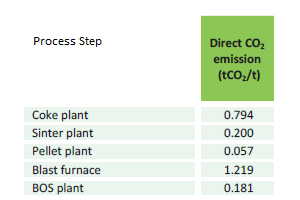Steel industry emissions of CO2
GHG emission levels in iron and steel production
The main process steps that generate carbon dioxide in iron and steelmaking are the production of coke, and the production of hot metal in the blast furnace. Ancillary facilities such as power plants also produce large volume of CO2. The table below identifies typical CO2 production volumes per tonne of output for each steelmaking process stage.

Figures show are for typical steel plants in the European Union. Source: European Commission - JRC Scientific and Policy Reports 'Prospective Scenarios on Energy Efficiency and CO2 Emissions in the EU Iron and Steel Industry', 2012 publication, see table 2, page 13.
Direct emissions from integrated BOF plants typically amount to 1.8-3.0 tonnes CO2 per tonne of steel produced. DRI-based EAF plants emit approx. 2-3 tonnes CO2 per tonne of steel if they are coal based, or 0.7-1.2 tonnes/tonne if they are gas-based. Emissions from scrap based EAF plants are mostly indirect –the CO2 emissions are not produced by the steel plant, but by the electricity generators that supply electricity to the furnaces. For a typical EAF, direct emissions are usually around 0.06-0.1 t/t; indirect emissions can add a further 0.4 t/t CO2. For discussion, see Review on the Use of Alternative Carbon Sources in EAF Steelmaking, Fig 1.
According to the World Steel Association, average greenhouse gas emissions per tonne of worldwide crude steel output stand at ~1.8 t/t [see worldsteel indicators report].

To contact us about steel industry greenhouse gas emissions please email info@steelonthenet.com.




